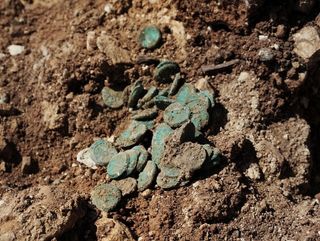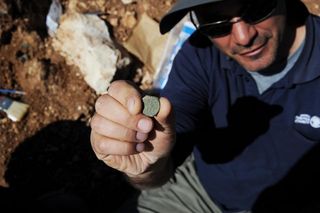Rare Coins Bear Scars of Ancient Jewish Rebellion

A Late Second Temple Period Jewish settlement with a trove of rare bronze coins inside one of its houses has been discovered in Israel.
The 114 bronze coins, which were found inside a ceramic money box and hidden in the corner of a room, date to the fourth year of the Great Revolt of the Jews against the Romans — an uprising that destroyed the Temple on Tisha B'Av about 2,000 years ago, the Israel Antiquities Authority (IAA) reported today (Aug. 5).
"The hoard, which appears to have been buried several months prior to the fall of Jerusalem, provides us with a glimpse into the lives of Jews living on the outskirts of Jerusalem at the end of the rebellion," Pablo Betzer and Eyal Marco, excavation directors on behalf of the IAA, said in a statement. "Evidently, someone here feared the end was approaching and hid his property, perhaps in the hope of collecting it later when calm was restored to the region." [Photos: Roadside Dig Reveals 10,000-Year-Old House in Israel]
The first of many uprisings by the Jews against the Romans, the Great Revolt began in A.D. 66 and was ultimately unsuccessful. The Romans eventually took Jerusalem back from the Jews, destroying much of the city and its Second Temple in the process.

Stamped on one side of the coins are a chalice and Hebrew inscription that translates to "To the Redemption of Zion." On the other side, the coins bear a motif with a bundle of lulav (palm branch) between two etrogs(a type of yellow citron) and the Hebrew inscription "Year Four," referring to the fourth year of the Great Revolt, around the year 69 or 70.
During excavation, two other rooms and a courtyard were uncovered in the settlement where the coins were found. The settlement was built in the first century B.C. and was destroyed during the Revolt in 69 or 79, according to the IAA statement. Then, early in the second century, people found use for the building again, for a stint that ended in the destruction of the Jewish settlement in Judea during the Bar Kokhba rebellion (A.D. 132 – 135).
The residents of this village were likely actively involved in both of these major rebellions against the Romans (the Great Revolt and the Bar Kokhba Revolt), IAA representatives said.
Sign up for the Live Science daily newsletter now
Get the world’s most fascinating discoveries delivered straight to your inbox.
Pottery shards found several months ago during construction of the new Highway 1 — the main road connecting Jerusalem and Tel Aviv — led to an excavation of the site and the new findings. Digging up the past during such construction projects is relatively common in Israel. For instance, during construction to expand Highway 1, archaeologists at Tel Motza uncoveredtwo 9,500-year-old cultic figurines— one depicting a ram with spiral horns, and the other a wild bovine.
Also found at this site during the expansion project were vessels and figurines inside a 2,750-year-old temple. During another construction project in the Jezreel Valley — this one a natural-gas pipeline — archaeologists found a 3,300-year-old clay coffin, whose lid was sculpted to look like a person, and likely belonged to a wealthy elite, perhaps an Egyptian army officer, IAA officials reported in April. And during excavations that were part of the new Highway 44 project in Ramla in central Israel, the remains of a wealthy estate with a mosaic fountain in its garden, all dating to the late 10th and early 11th centuries, were discovered.
Follow Jeanna Bryner on Twitter and Google+. Follow us @livescience, Facebook & Google+. Original article on Live Science.
Jeanna Bryner is managing editor of Scientific American. Previously she was editor in chief of Live Science and, prior to that, an editor at Scholastic's Science World magazine. Bryner has an English degree from Salisbury University, a master's degree in biogeochemistry and environmental sciences from the University of Maryland and a graduate science journalism degree from New York University. She has worked as a biologist in Florida, where she monitored wetlands and did field surveys for endangered species, including the gorgeous Florida Scrub Jay. She also received an ocean sciences journalism fellowship from the Woods Hole Oceanographic Institution. She is a firm believer that science is for everyone and that just about everything can be viewed through the lens of science.
